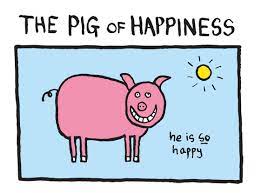Last weekend, I spent a very happy couple of hours at the Van Gogh immersive exhibition in York (which I highly recommend if you like a combination of deckchairs in a church, beautiful music, and all things Van Gogh). A number of quotes from Van Gogh were included during the exhibition, including this one:
‘The great does not happen through impulse alone, and is a succession of little things that are brought together’.
On further investigation, it transpires that Van Gogh wrote these words in 1882 as part of a letter to his brother, Theo. He was talking about an ‘invisible iron wall’ that seemed to stand between feeling and acting in the context of creating drawings, and how breaking through that wall was a process requiring patience and perseverance.
I found myself very much drawn to that phrase, ‘a succession of little things’. It reminded me of my old pal, the Pig of Happiness – anyone who’s heard me speak will know he’s one of my guiding lights.

You can read more about my enduring love for the happy pig here, and I’m delighted that both he and Van Gogh are expressing the same idea: that for change to happen, we can’t expect to wave a magic wand and *ta-dah!*. Rather, we must be patient and keep persevering with our goal in mind.
I think anyone who has experienced or led organisational change can relate to this: it’s a long and winding road, and at times those invisible iron walls along the way, as suggested by Van Gogh, can seem insurmountable.
As Van Gogh goes on to say in the same letter,
‘And the great is not something accidental; it must be willed’.
Working with Insights Discovery has taught me so much about this idea of will in the context of leadership and change. Because we’re all complex beings, made up of many parts, ‘will’ is going to mean different things to different people. For some, it’s about driving change, leading from the front. For others, it might be about using charm and friendliness to persuade (maybe employing the old tea and cake methodology). For many of the healthcare professionals I’ve worked with, leading change is about understanding others’ perspectives and incorporating collaborative approaches. The point is, it’s always got to be up to us as individuals to understand what ‘will’ means to us, and then think about how our own inner Pig might approach change. And finally, work out what the succession of little things might be, in order to get over that progress-impeding wall.
If you’d like to know more about how Why Not can support you and your team in the context of change, get in touch. For now, pop along to watch the short cartoon about the Pig of Happiness and then consider your own approach to change. I challenge you to seek out some other Pigs and have a conversation about what ‘will’ looks like for each of you – you’ll definitely find that getting over the invisible wall can happen in a multitude of ways!

